Libyen |
|
|
|
| Übersicht – Contents: | |
Libyen |
|
|
|
| Übersicht – Contents: | |
Flagge – Flag: |
|
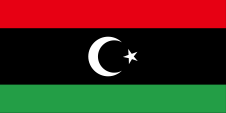 |
seit/since 2011, |
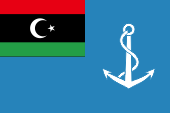 |
seit/since 2011, |
historische Flaggen – historical Flags: |
|
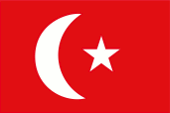 |
bis/to 1911, |
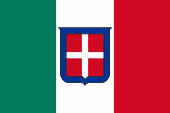 |
1911–1943, National- und Handelsflagge Italiens – national and merchant flag of Italy, Seitenverhältnis – ratio = 2:3, Quelle/Source, nach/by: Das Flaggenbuch  |
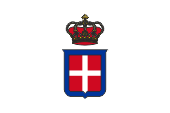 |
1911–1943, Flagge des Gouverneurs der italienischen Kolonie Libyen – flag of the Governor of the Italian colony of Libya, Seitenverhältnis – ratio = 2:3, Quelle/Source, nach/by: Das Flaggenbuch |
 |
1951–1969, |
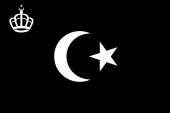 |
1951–1969, |
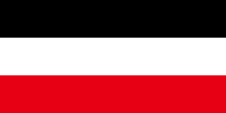 |
1969–1972, |
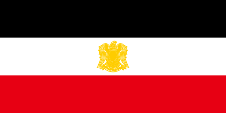 |
1972–1977, |
 |
1977–2011, Nationalflagge – national flag, Seitenverhältnis – ratio = 1:2, Quelle/Source, nach/by: Flags of the World    |
 |
1977–2011, Marineflagge – naval flag, Seitenverhältnis – ratio = 2:3, Quelle/Source: commons.wikimedia.org, Public domain, via Wikimedia Commons |
Landesteile – Countrysides: |
|
| Senussi Emirat (Cyrenaica): | |
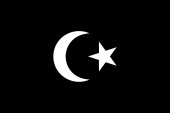 |
1949–1950, |
| Tripolitanien: | |
 |
1911–1913, |
| Tripolitanien: | |
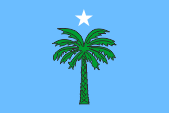 |
1918–1923, |
| Die heutige Flagge Libyens wurde während der Rebellion des Jahres 2011 wiederbelebt. Es handelt sich eigentlich um die Flagge des Königreiches Libyen, das zwischen 1951 und 1969 bestand. Sie zeigt drei Streifen in Rot, Schwarz und Grün im Verhältnis 1:2:1 mit einem silbernem Halbmond und Stern in der Mitte. Die Buntfarben der Flagge scheinen heute folgendermaßen definiert zu sein, und zwar hexadezimal: Rot = #e70013, was Pantone 1788 entsprechen würde, Grün = #239e46, was Pantone 355 entsprechen würde. | The
current flag of Libya was revived during the rebellion of 2011. It is
actually the flag of the Kingdom of Libya, which existed between 1951 and
1969. It shows three stripes in red, black and green in the ratio 1:2:1 with a silver crescent and star in the centre. The variegated colours of the flag seem to be defined today as follows, in hexadecimal: Red = #e70013, which would correspond to Pantone 1788, Green = #239e46, which would correspond to Pantone 355. |
| Libyen besteht aus den drei historischen Landesteilen Tripolitanien, Cyrenaica und Fessan. Tripolitanien wurde genau wie Cyrenaica von einer lokalen Dynastie beherrscht. Das blieb auch unter der Herrschaft der Osmanen so. Diese lokalen Herrscher durften zeitweilig neben der osmanischen Flagge auch eigene Flaggen verwenden, je nach dem ob sie im Moment gerade über eine begrenzte Autonomie verfügten oder nicht. Unter der Herrschaft der Italiener wurde dieses Prinzip bis in die zwanziger Jahre des 20. Jahrhunderts beibehalten. | Libya
consists of the three historical countrysides Tripolitania, Cyrenaica and
Fezzan. Tripolitania was, exactly like Cyrenaica, ruled by a local dynasty.
This persists even under the rule of the Ottomans.
These local sovereigns was it temporary allowed to use beside the Ottoman
flag even own flags, however if they had momentary a limited autonomy or
not. |
| Während und nach dem Zweiten Weltkrieg verblieb Libyen zwar bei Italien, wurde aber in eine britische und eine französische Besatzungszone aufgeteilt. Tripolitanien und Cyrenaica gehörten zur britischen Zone, Fessan war französisch. Nach dem Pariser Frieden von 1947 musste Italien auf Libyen verzichten und Libyen wurde Treuhandgebiet der UN. Die Besatzungszonen blieben erhalten. Bereits 1949 entschied die UN die Cyrenaica unter dem Senussi-Orden und seinem Emir Mohammed Idris as-Senussi die Unabhängigkeit zu entlassen. Ganz Libyen wurde ab 1952 die Unabhängigkeit zugesagt. Die Flagge des Senussi-Emirats war schwarz mit silbernem Halbmond und Stern in der Mitte. | During and after the Second World War Libya remains indeed at Italy, but was dismembered in a British and a French occupation zone. Tripolitania and Cyrenaica belonged to the British zone, Fezzan was French. After the Peace of Paris in 1947 Italy has to waive Libya and Libya became a trust territory of the UN. The occupation zones persist. Already in 1949 the UN decided to eject the Cyrenaica in independence under the Senussi-Order and its Emir Mohammed Idris as-Senussi. For whole Libya was promised the independence for the year 1952. The flag of the Senussi Emirate was black with silvery half-moon and star in the middle. |
| Nachdem Libyen als Vereinigtes Königreich unabhängig geworden und der Senussi-Emir König geworden war, wurde diese schwarze Flagge, ergänzt um eine Krone, als Flagge des Königs beibehalten. Die bei der Erlangung der Unabhängigkeit eingeführte Nationalflagge war diejenige der Cyrenaica, jedoch ergänzt um einen roten Streifen oberhalb des schwarzen, breiten mittleren Streifens und um einen grünen Streifen unterhalb. Die drei Streifen sollten die drei Landesteile Fessan, Cyrenaica und Tripolitanien repräsentieren. | After
Libya became independet as United Kingdom and the Senussi Emir became the
King, this black flag was, added by a crown, maintained as flag of the King. The in context with the achievement of the independence introduces national flag was that of the Cyrenaica, however completed by a red stripe above the black and broad middle stripe and by a green stripe below. The three stripes should represent the three countrysides Fezzan, Cyrenaica und Tripolitania. |
| Mit der Bildung der Republik (1969) wurde eine Flagge in den nasseritischen Farben Rot, Weiß und Schwarz eingeführt, jedoch ohne Sterne in der Mitte. Außerdem wurde ein Wappen eingeführt, das demjenigen Ägyptens sehr ähnlich war. Am 01.01.1972 wurde die gemeinsame Flagge der Föderation Arabischer Republiken eingeführt, waagerecht gestreift in den Farben Rot, Weiß und Schwarz mit dem Wappen der Föderation (der Falke der Koraischiden) in Gold in der Mitte. Der einzige Unterschied bestand im Schriftzug unterhalb des Adlers. Als am 19.11.1977 Ägypten Friedensgespräche mit Israel begann, wurden in Libyen die Föderationflaggen heruntergerissen und verbrannt. Libyen nahm die grüne Flagge an. | In context with the nascence of the republic (1969) was introduced a flag in the Nasseritic colours red, white and black, however without a star in the middle. Moreover was introduced a coat of arms, which was very similar to the coat of arms of Egypt. On 1st of January in 1972 was introduced the common flag of the Federation of Arabic Republics, horizontal striped in the colours red, white and black with the coat of arms of the federation (the hawk of the Koraischids) in gold in the middle. The only difference was the inscription below the eagle. When Egypt began peace-negotiations with Israel on the 19th of November in 1977, in Libya were pull down the federation flags and burned. Libya adoped the green flag. |
| Die einfarbige grüne Flagge, entsprach der Farbe des Islam, war aber auch eine Erinnerung an die "Grüne Revolution", zu der der 1969 an die Macht gekommene Oberst Muammar Al-Gaddafi aufrief, der Libyen in ein Lebensmittel produzierendes Land verwandeln wollte. | The single-coloured green flag of Libya corresponded to the colour of the Islam – but was also a reminder to the "Green Revolution", which proclaimed the in 1969 to the power came Colonel Muammar Al-Gaddafi, who wanted to transform Libya in a food producing country. |
| Der Farbendreiklang von Rot, Weiß und Schwarz wird manchmal als Panarabische Farben bezeichnet. Das ist so nicht ganz richtig. Die drei Farben gehen zurück auf Gamal Abd el-Nasser, ägyptischer Offizier, Politiker sowie späterer Staats- und Ministerpräsident (1918–1970), wichtigster Vertreter des arabischen Nationalismus und Panarabismus. Nach der nationalen Revolution des Jahre 1952 wurde in Ägypten die Arabische Befreiungsflagge eingeführt, welche eben diese Ideale repräsentierte. Sie wurde, zumindest in der Auswahl und Anordnung Vorbild für viele andere arabische Staaten und Staatenbündnisse. Die Farben stehen immer für die Revolution (Rot), die Zukunft (Weiß) und die Vergangenheit (Schwarz). Die Farben Rot, Weiß und Schwarz gehen auf die Flagge des Arabischen Aufstandes im Ersten Weltkrieg zurück. Zu den Farben des Arabischen Aufstandes (Arabische Bewegung) gehört allerdings noch Grün. | The
colour triad of red, white and black is referred as Panarabian colours.
This is not entirely correct. The three colours go back to the late Gamal
Abd el-Nasser (1918–1970), Egyptian military officer, politician as well as
later the state's president and prime minister, and most important
representative of the Arabian nationalism and panarabism. After the national revolution of 1952 the Arabian Liberation Flag was introduced in Egypt, which represented those ideals. It was, at least in choice and arrangement a model for many
other Arabian states and state alliances. The colours stand always for the
revolution (red), the future (white) and the past (black). The colours have
their roots in the flag of the Arabian Revolt during the First World War.
Yet the colours of the Arabian Revolt (Arabian Movement) include even green. |
| Quelle/Source: Flaggen und Wappen der Welt, Die Welt der Flaggen, Flaggen Wappen Hymnen, Wikipedia (EN) | |
Wappen – Coat of Arms: |
|
 |
seit/since 2021, Wappen von Libyen – coat of arms of Libya, Quelle/Source: Government of National Unity of the State of Libya, Public domain, via Wikimedia Commons |
historische Wappen – historical Coats of Arms: |
|
 |
1969–1972, Wappen von Libyen – coat of arms of Libya, Quelle/Source: Corel Draw 4 |
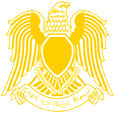 |
1972–1977, Wappen von Libyen – coat of arms of Libya, Quelle/Source: Corel Draw 4 |
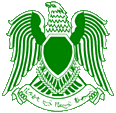 |
1977–ca.1990, Wappen von Libyen – coat of arms of Libya, Quelle/Source: Corel Draw 4 |
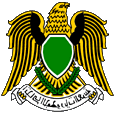 |
ca.1990–2011, Wappen von Libyen – coat of arms of Libya, Quelle/Source: Corel Draw 4 |
| Bei der
Proklamation der Republik wurde ein Wappen eingeführt, das demjenigen
Ägyptens fast genau glich, und den Adler Saladins zeigte. Im Zusammenhang
mit dem Inkrafttreten der Föderation Arabischer Republiken (Ägypten, Syrien,
Libyen) am 01.01.1972 wurde auch ein neues Wappen, das Wappen der Föderation
eingeführt. Es zeigte den Falken der Koraischiden in Gold. Der einzige
Unterschied war das Spruchband in den Fängen des Adlers. Bei Libyen stand
dort: "Arabisch-Libysche Republik". Mit dem Ende der Föderation am 19.11.1977 änderte Libyen sein Staatswappen ab. Der Falke hatte nun ein grünes Brustschild und blickte im heraldischen Sinne nach Rechts. Wahrscheinlich seit dem Ende der 80-er Jahre des 20. Jahrhunderts verwendete Libyen den Falke in einer schwarz-goldenen Ausführung, nur das Brustschild und die Olivenzweige blieben grün, und der Falke blickt wieder nach Links. |
When there was the proclamation of the republic it was introduced a coat of arms, which was very similar to the coat of arms of Egypt, and showed the Eagle of Saladin. In context with the come into force of the Federation of Arabic Republics (Egypt, Syria, Libya) on the 1st of January in 1972 was also introduced a new coat of arms, the coat of arms of the federation. It showed the Hawk of the Koraischids in gold. The only difference was the inscription on the banner in the catch of the eagle. At the Libyan eagle there was written: "Arabic-Libyan Republic". With the end of the federation on 19th of November in 1977, Libya changed its national coat of arms. The flacon had now green breast shield and facing to the right in the heraldic sense. Probably since the end of the eighties of the 20th century Libya used the hawk in a black-golden design, only the chest shield and the olive twigs remained green and the hawk peeks to the left side again. |
| Quelle/Source: Flaggen und Wappen der Welt, Die Welt der Flaggen, Flaggen Wappen Hymnen, Wikipedia (EN) | |
Flugzeugkokarde – aircraft roundel: |
|
 |
1962–1969, Flugzeugkokarde – aircraft roundel Quelle/Source, nach/by: Wikipedia (EN) |
 |
1969–1977, Flugzeugkokarde – aircraft roundel Quelle/Source, nach/by: Wikipedia (EN) |
 |
1977–2011, Flugzeugkokarde – aircraft roundel Quelle/Source, nach/by: Wikipedia (EN) |
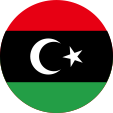 |
2011–2014, Flugzeugkokarde – aircraft roundel Quelle/Source, nach/by: Wikipedia (EN) |
Landkarte – Map: |
Lage – Position: |
Landkarte des Landes – Map of the Country: |
|
|
|
| Quelle/Source: Freeware, University of Texas Libraries, modyfied by: Volker Preuß |
| Zahlen und Fakten – Numbers and Facts: | |
|
|
|
|
|
|
|
|
|
|
|
|
|
|
|
|
|
|
|
|
|
|
500 v.Chr.
· Kolonisierung der Cyrene (Cyrenaica) durch Griechen, Kolonisierung von
Tripolitanien durch Karthago 201 v.Chr. · Karthago muss nach dem 2. Punischen Krieg Tripolitanien an das Römische Reich abtreten 74 v.Chr. · Eroberung von Cyrene (Cyrenaica) durch das Römische Reich 395 · bei der Teilung des Römischen Reiches kommt Cyrene (Cyrenaica) an das Oströmische Reich (Byzanz), und Tripolitanien zum Weströmischen Reich 439 · die Wandalen erobern Nordafrika und gliedern Tripolitanien ihrem Reich ein 533 · das Wandalenreich wird von Byzanz erobert 642–643 · Eroberung von Cyrene (Cyrenaica) durch das Arabische Kalifat 667–670 · Eroberung von Tripolitanien durch das Arabische Kalifat, in der Folgezeit Einwanderung von Arabern, Islamisierung, weitgehende Vertreibung der ursprünglichen Einwohner 1509–1551 · Tripolis ist spanische Kolonie 1521 · Eroberung von Cyrenaica durch das Osmanische Reich, Eingliederung als Provinz Barka 1551 · Eroberung von Tripolitanien durch das Osmanische Reich, Eingliederung als Provinz Tripolis ca. 1560 · Eroberung von Fessan (Tuareg-Staat) durch das Osmanische Reich, Eingliederung als Provinz Fessan 1911–1912 · Italienisch-Türkischer Krieg, Italien erobert Tripolitanien und die Cyrenaica 1925 · Italien erobert den Fessan 1934 · Zusammenfassung der italienischen Besitzungen Tripolitanien, Cyrenaica und Fessan zur Kolonie Libyen (Libia) 1939–1945 · Zweiter Weltkrieg: Fessan wird 1942 von Truppen des Freien Frankreich bestzt, Tripolitanien und die Cyrenaica werden 1942–1943 von britischen Truppen erobert, Aufteilung in eine britische und eine französische Besatzungszone 1947 · Frieden von Paris, Italien muss auf Libyen verzichten, Libyen wird Treuhandgebiet der UNO 1949 · Cyrenaica wird unter dem Senussi-Orden und seinem Emir Mohammed Idris as-Senussi unabhängig 24.12.1951 · ganz Libyen wird als Vereinigtes Königreich Libyen unabhängig (die Länder Tripolitanien, Cyrenaica und Fessan sind autonome Landesteile und bilden eine Föderation), Emir Mohammed Idris as-Senussi wird König Idris I., die USA und Großbritannien erhalten Militärstützpunkte (Wheelus Field, Tripolis, Mursuk und Tubruk) 15.04.1963 · neue Verfassung, die drei Länder werden aufgelöst und werden in Verwaltungseinheiten aufgeteilt 01.09.1969 · nationalistische arabische Offiziere unter Führung von Oberst Muammer Al-Ghadafi stürzen die Monarchie und proklamieren die Republik 1970 · USA und Großbritannien müssen ihre Stützpunkte räumen, italienische Siedler und alle Juden müssen das Land verlassen 1972–1977 · rein formale Föderation mit Syrien und Ägypten in der Union Arabischer Republiken (bis zum 19.11.1977) 1973 · Libyen besetzt den Aozou-Streifen im Norden des Tschad 1977 · neue Verfassung, Libyen nennt sich jetzt Sozialistische Libysche Arabische Volksjamahiriya (Jamahiriya = Massenstaat) 1980–1989 · Libyen engagiert sich im Bürgerkrieg des Tschad 1980–1988 · Libyen unterstützt den Iran im Ersten Golfkrieg (Iran gegen Irak) 1986 · militärische Intervention der USA gegen Libyen, Bombardierung von Tripolis und Bengasi 1989 · Friedensvertrag mit dem Tschad, der Aozou-Streifen bleibt von Libyen besetzt 1991 · Libyen unterstützt den Irak im Zweiten Golfkrieg (USA gegen Irak) 1992, 1993 · Sanktionen der UNO gegen Libyen 1994 · Libyen räumt unter Aufsicht der UNO den Aozou-Streifen im Tschad 1999 · die UNO-Sanktionen von 1992 und 1993 werden aufgehoben 2005 · Normalisierung der internationalen Beziehungen Februar 2011 · zunächst Demonstrationen, später Aufstand gegen die Herrschaft von Oberst Muammer Al-Ghadafi, vor allem in Cyrenaica, allmählicher und stetiger Vormarsch der Aufständischen unter Feuerschutz der NATO 22.08.2011 · Eroberung von Tripolis durch die Aufständischen, Sturz der Herrschaft von Oberst Muammer Al-Ghadafi, ein Nationaler Übergangsrat übernimmt de facto die Macht 20.10.2011 · Oberst Muammer Al-Ghadafi wird bei Kämpfen in seiner Heimatstadt Syrte nach seiner Gefangennahme von den Aufständischen bestialisch gefoltert und ermordet 06.03.2012 · die Region Cyrenaica erklärt sich für autonom 2012–2021 · Libyen zerfällt in Machtbereiche verschiedener Warlords und Milizen, darunter islamische (in Cyrenaica) und radikal-islamische Milizen (in Tripolitanien), ethnische Milizen der Tubu und der Tuareg (in Fessan), und militärische Verbände von Al-Kaida und Islamischer Staat (Küstenstädte), es gibt zwei große verfeindete Gruppierungen, mit eigenem libyschen Parlament: Abgeordnetenrat (in Tobruk, Cyrenaica, international anerkannt), Allgemeiner Nationalkongress (in Tripolis, Tripolitanien, international nicht anerkannt) 05.02.2021 · Abgeordnetenrat und Nationalkongress einigen sich auf eine gemeinsame Präsidentschaft und einen Premier, die eine Übergangsregierung bis zu den nächsten freien Wahlen bilden sollen |
|
500 B.C.
· colonization of the Cyrene (Cyrenaica) by Greek, colonization of
Tripolitania by Karthago 201 B.C. · Karthago has to cede Tripolitania to the Roman Empire after the 2nd Punic War 74 B.C. · conquest of Cyrene (Cyrenaica) by the Roman Empire 395 · at the partition of the Roman Empire the Cyrene (Cyrenaica) comes to the East Roman Empire (Byzantium), and Tripolitania to the West Roman Empire 439 · the Vandals conquer Northern Africa and incorporate Tripolitania into their Empire 533 · the Vandal's Empire becomes conquerd by Byzantium 642–643 · conquest of Cyrene (Cyrenaica) by the Arabic Califate 667–670 · conquest of Tripolitania by the Arabic Califate, in the afteryears immigration of Arabs, islamization, broadly expulsion of the original inhabitants 1509–1551 · Tripoli is a Spanish colony 1521 · conquest of Cyrenaica by the Ottoman Empire, incorporation as Province of Barka 1551 · conquest of Tripolitania by the Ottoman Empire, incorporation as Province of Tripoli ca. 1560 · conquest of Fezzan (Tuareg State) by the Ottoman Empire, incorporation as Province of Fezzan 1911–1912 · Italian-Turkish War, Italy conquers Tripolitania and Cyrenaica 1925 · Italy conquers Fezzan 1934 · summary of the Italian possessions of Tripolitania, Cyrenaica and Fezzan to the Colony of Libya (Libia) 1939–1945 · Second World War: Fessan becomes occupied in 1942 by troops of the Free France, Tripolitania and Cyrenaica become conquered between 1942 and 1943 by British troops, division in a British and a French occupation zone 1947 · Peace of Paris, Italy has to renounce Libya, Libya becomes a trust territory of the UNO 1949 · Cyrenaica becomes independent under the Senussi-Order and its Emir Mohammed Idris as-Senussi 24th of December 1951 · whole Libya becomes independent as United Kingdom of Libya (the countries Tripolitania, Cyrenaica and Fezzan are autonomous countrysides and form a federation), Emir Mohammed Idris as-Senussi becomes King Idris I., the USA and United Kingdom get military bases (Wheelus Field, Tripoli, Mursuq and Tubruq) 15th of April 1963 · new constitution, the three countries become dissolved and partitioned in administration units 1st of September 1969 · nationalist and Arabic military officers under leadership of Colonel Muammer Al-Ghadafi unseat the monarchy and proclaim the republic 1970 · the USA and United Kingdom have to leave their bases, Italian settlera and all Jews have to abandon the country 1972–1977 · only formal federation with Syria and Egypt in the Union of Arabic Republics (until the 19th of November in 1977) 1973 · Libya occupies the Aozou Stripe in the north of Chad 1977 · new constitution, Libya names itself now Socialistic Libyan Arabic People's Jamahiriya (Jamahiriya = state of the masses) 1980–1989 · Libya is concerned in the civil war of the Chad 1980–1988 · Libya supports the Iran in the First Gulf War (Iran against Iraq) 1986 · military intervention of the USA against Libya, bombardment of Tripoli and Benghazi 1989 · peace treaty with the Chad, the Aozou Stripe is furthermore occupied by Libya 1991 · Libya supports the Iraq in the Second Gulf War (USA against Iraq) 1992, 1993 · sanctions of the UNO against Libya 1994 · Libya evacuates under the eyes of the UNO the Aozou Stripe in the Chad 1999 · the UNO sanctions of 1992 and 1993 become terminated 2005 · normalization of the international relationships February 2011 · at first demonstrations, later open rebellion against the rule of Colonel Muammer Al-Ghadafi, especially in Cyrenaica, gradual and steady advance of the rebels under fire of NATO 22nd of August 2011 · conquest of Tripoli by Democrats, overthrow of the rule of Colonel Muammer Al-Khadafi, a National Transitional Council takes over 20th of October 2011 · Colonel Muammar Al-Khadafi is killed during fights in his hometown of Sirte after his capture he becomes brutally tortured and murdered by the rebels 6th of March 2012 · the Region of Cyrenaica declares itself for autonomous 2012–2021 · Libya is divided into areas of various warlords and militias, including Islamic (in Cyrenaica) and radical Islamic militia (in Tripolitania), ethnic militias of the Tubu and Tuareg (in Fezzan), and troops of Al-Qaeda and Islamic State (coastal cities), there are two major warring factions, with an own Libyan Parliament: Council of Deputies (in Tobruk, Cyrenaica, internationally recognized), General National Congress (in Tripoli, Tripolitania, internationally not recognized) 05.02.2021 · Council of Deputies and National Congress agree on one joint presidency and a prime minister holding a transitional government to form until the next free elections |
| Quelle/Source: Atlas zur Geschichte, Wikipedia (D), Discovery '97, Volker Preuß |
| Dazu gibt es drei Theorien: | There are three theories about this: |
| 1.) | 1.) |
| Der griechische Name "Libya" geht auf ein ursprünglich von den Ägyptern im Altertum verwendetes Wort zurück. Sie bezeichneten damit alle Territorien die im Westen an ihr Reiches angrenzten. Die Griechen haben es übernommen und das Wort "Libya" für ganz Afrika mit Ausnahme Ägyptens verwendet. | The Greek
name "Libya" has its roots in an initially by the Egyptians in the antique
used word. They had designated with this all territories which border in the
west on their empire. The Greek took this word over and used the word "Libya" for whole Africa except Egypt. |
| 2.) | 2.) |
| Der Name "Libya" ist der arabische Name der berberischen Mondgöttin "Kar", die nicht nur in Libyen, sondern in ganz Nordafrika verehrt wurde. Er heißt übersetzt angeblich "vor Regen tropfend". | The name "Libya" is the Arabic name of the Berber moon goddess "Kar", who was worshipped not only in Libya but throughout whole North Africa. It is said to translate as "dripping with rain". |
| 3.) | 3.) |
| Das Wort "Libya" heißt in einer alten, antiken, nicht genau zu identifizierenden Sprache "Flamme" oder "entflammt", vielleicht eine Anspielung auf die heiße Steinwüste Hammada al-Hamra. |
The word "Libya" means
"flame" or "inflamed" in an ancient, not exactly identifiable language,
perhaps a reference to the hot stone desert Hammada al-Hamra. |
| Quelle/Source: Handbuch der geographischen Namen, Atlas der wahren Namen, Volker Preuß | |
| Seit dem Ende der Herrschaft von Oberst Muammar Al-Ghadafi, tritt der Gegensatz zwischen dem Osten und dem Westen des Landes verstärkt zu Tage. Der Westen gilt als liberal, der Osten als religiös. Der Osten Libyens ist die Region Cyrenaica, die sich unter Ghadafi Benachteiligungen ausgesetzt gesehen hat, und diese jetzt kompensieren möchte. Es gibt Pläne Libyen in die drei früheren Regionen Tripolitanien, Cyrenaica und Fessan aufzuteilen, eine Politik, die vor allem von Cyrenaica aus betrieben wird. Die Teilungspläne sind recht konkret, und die Absicht das Land Cyrenaica bis zu den libyschen Ölfeldern und Ölhäfen auszudehnen enthalten jede Menge politischen Sprengstoff. Die Flaggenfrage scheint für Cyrenaica auch schon entschieden. | Since the
end of the reign of Colonel Muammar Al-Khadafi, the contrast between the
east and the west of the country becomes more common. The West is regarded
as liberal, the East as religious. The east of Libya is the region of
Cyrenaica, which has seen itself in discrimination under Khadafi, and now
wants to compensate for this. There are plans to divide Libya in the three
former regions of Tripolitania, Cyrenaica and Fezzan, a policy that is
operated primarily out of Cyrenaica. The division plans are quite specific,
and the intention to expand the country Cyrenaica to the Libyan oil fields
and oil ports contain a lot of political dynamite. The flag issue seems
already decided to Cyrenaica. |
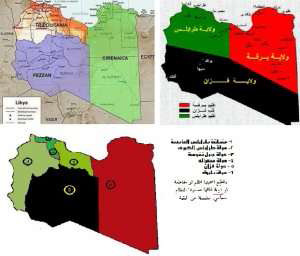 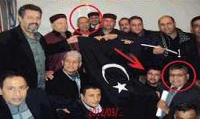 |
|
| Quelle/Source: julius-hensel.com | |